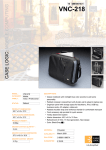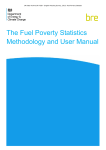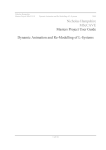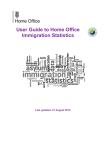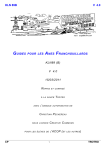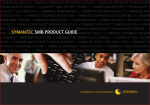Download User Guide to Alcohol and Late Night Refreshment
Transcript
User Guide to Alcohol and Late Night Refreshment Licensing Statistics Last Updated: December 2014 Contents Page 1 Introduction.......................................................................................................................................... 3 2 Glossary of terms ................................................................................................................................ 7 3 Conventions used in Alcohol and Late Night Refreshment Licensing Statistics ..................... 10 4 Types of licence ................................................................................................................................ 12 5 Other measures ................................................................................................................................. 13 6 Appendix A: Key stages in the production of the statistical release........................................... 15 2 1 Introduction Purpose of the collection The main purpose of this collection is to monitor the administration of the Licensing Act 2003 (the 2003 Act) including amendments, such as those introduced by the Police Reform and Social Responsibility Act 2011 (the 2011 Act). It provides information to help licensing authorities (LAs) benchmark their position and provide understanding in the context of the national picture. These data have been collected from LAs that completed a statistical return. This collection is in line with the first Licensing Act 2003 data collection, which was conducted in 2007. The Department for Culture, Media and Sport (DCMS) previously produced these statistics but in 2010 responsibility for alcohol licensing and late night refreshment under the 2003 Act was transferred to the Home Office whilst the responsibility for regulated entertainment was retained by DCMS. The Home Office therefore took over responsibility for the alcohol and late night refreshment licensing statistics. No collection was conducted for 2010/11. The collections from 2011/12 onwards are broadly consistent with the final DCMS collection in 2010. Coverage includes licences for the sale of alcohol or provision of late night refreshment. This collection does not record the number of public houses, as the 2003 Act does not legally define these (the Act defines activities not premises types). Due to difficulties in classification we do not ask licensing authorities to report details of whether a premises is a pub, bar, club, store etc. The existence of a premises licence or club premises certificate with authorisation to sell or supply alcohol, provide late night refreshment or provide regulated entertainment, does not necessarily mean that all such premises are actually providing such a service. For example, a premises may possess an authorisation to sell alcohol but does not actually sell alcohol. Licensing Act 2003 The 2003 Act changed the way that alcohol and entertainment licensing was administered when it came into force in November 2005. It established an integrated scheme for licensing premises that are used for the supply of alcohol, to provide regulated entertainment or to provide late night refreshment. Providers are able to carry out some or all of these licensable activities under a single authorisation: a temporary event notice (TEN), premises licence or club premises certificate. Key measures contained in the 2003 Act include the following. Flexible opening hours, with the potential for up to 24-hour opening, seven days a week, subject to consideration of the impact on local residents, businesses and the expert opinion of a range of authorities in relation to the statutory licensing objectives (the prevention of crime and disorder; the prevention of public nuisance; public safety; and the protection of children from harm). Early morning alcohol restriction orders (EMROs) which allow LAs to restrict the sale of alcohol between the hours of 12am and 6am in all or part of their local areas. Premises licences which are issued by LAs after scrutiny of all applications by the police and other responsible authorities. Until April 2012, only those living in, and businesses operating in, the vicinity of the premises could also make representations about applications. This limitation to those ‘in the vicinity’ was abolished under the changes introduced via the Police Reform and Social Responsibility Act 2011 (the 2011 Act). Club premises certificates which allow clubs or organisations where members have joined together for particular social, sporting or political purposes to combine to buy alcohol in bulk as members of the organisation to supply in the club. 3 Personal licences which allow the holder to authorise the sale of alcohol. The law requires that all sales of alcohol at a licensed premises, subject to certain exemptions, are authorised by a personal licence holder. The full text of the 2003 Act is available at: http://www.legislation.gov.uk/ukpga/2003/17/contents. The 2011 Act contains amendments to the 2003 Act. Commencement of its provisions started in 2012/13 and is expected to finish in 2014/15. The alcohol licensing returns for this period will reflect these changes so that users can compare results pre- and post-implementation. The 2012/13 return reflects the reform of the system of temporary event notices (TENs) with the collection of separate figures for standard and late notices (see Chapter 5 for more details). The 2013/14 return incorporates further provisions of the 2011 Act, specifically on early morning alcohol restriction orders (EMROs) and late night levy orders. Data reported in this bulletin To allow accurate comparisons with previous years’ data, the headline figures within this release include modelled estimates for the LAs which were unable to supply data. Some breakdowns only include data from responding LAs as it was not always possible to produce reliable modelled estimates for the non-respondents as the figures are of a smaller, disaggregated nature and the response rate for these figures is generally lower. A full version of the questionnaire for each year and the individual response rates for each question are available on the Home Office pages of the www.gov.uk website (please refer to the landing page for the release for a particular year for a link to the document). Quality and methodology The statistical collection covered by this release is a by-product of local authority administrative processes. They are all listed in the Single Data List (SDL) document, which can be found at: https://www.gov.uk/government/policies/making-local-councils-more-transparent-and-accountable-to-localpeople/supporting-pages/single-data-list Key stages of the collection process are listed in Appendix A. The published figures on alcohol and late night refreshment licensing are sourced from licensing authorities’ licensing records and as such the quality and reliability is good. Nevertheless, the figures are always subject to the inaccuracies inherent in any large recording system and are not necessarily accurate to the last digit. Furthermore, not all authorities provide returns, and some returns are incomplete. Estimates are made for non-response (as described in Chapter 3). Any quality deficiencies for a particular year’s data are listed in the ‘Data quality and interpreting the figures’ section of that year’s main release. The 2013/14 return asked LAs for an estimate of the time taken to complete the return. The replies showed that it took an average of seven hours to do this. Uses Statistics on alcohol and late night refreshment licensing are used for a variety of purposes, which are listed in general terms using the standard categorisation for official statistics (as shown in the UK Statistics Authority monitoring brief 6/2010, The Uses Made of Official Statistics, 4 http://www.statisticsauthority.gov.uk/assessment/monitoring/monitoring-reviews/index.html). Specific uses for a particular year appear in the main release. Informing the general public’s choices: a) about the state of the economy, society and the environment consumption and opening hours of licensed premises; in particular, alcohol b) about the performance of government and public bodies – in particular, the impact of legislation. Figures are requested via Parliamentary Questions and Freedom of Information cases to gauge performance in general or specific areas. Government policy-making and monitoring: statistics are used to monitor the performance and effectiveness of the licensing process. Informing public marketing campaigns: statistics are used to measure the effectiveness of the roll-out of licensing changes e.g. changes to opening hours. Supporting third sector activity – lobbying: statistics are used by a variety of civil liberties and community safety lobbies. Facilitating academic research: potential use here (but limited evidence at present). User experiences The Home Office conducted a survey for the 2013/14 Alcohol and Late Night Refreshment Licensing statistical release so that the department could assess how well it met users’ needs and could potentially make improvements where possible. There were 40 responses to the survey, of which: Over three-quarters were from licensing authorities. The remaining responses were from universities/schools, the general public and the wider public sector. Nearly two-thirds of respondents found all the information they required. Of those that found only some or none of the information they sought, the main comments received were that they wanted information at a local level. For respondents that had provided their email address, the Home Office then emailed them a link to the supplementary data tables, which provide information at a local level. These tables are actually on the Alcohol and Late Night Refreshment Licensing statistics section of the gov.uk website. However, it is possible users might not have spotted them. Around half of respondents indicated that they had used the commentary and/or the statistical news release and/or the data tables. Around a quarter stated that they had used the user guide. For those respondents that had used them, the majority were satisfied with the respective parts of the release. The most common use of the information was for comparative analysis between licensing authorities. Figures for other countries The Scottish Government annually publishes Scottish Liquor Licensing Statistics under the Licensing (Scotland) Act 2005. These include headline figures on the number of premises and personal licences in force. The former includes licences for registered clubs, the equivalent to club-registered certificates, which are collected separately in England and Wales. The release also includes figures on the number of premises licences applied for, granted, and refused. The Scottish Liquor Licensing Statistics are broadly comparable with those for England and Wales. The Northern Ireland Executive does not publish alcohol/liquor licensing statistics. 5 Acknowledgements This release and the accompanying datasets have been prepared by staff in the Home Office Statistics Unit of Home Office Science. We would like to thank staff in the Policing Data Collection Section in the Home Office and in the licensing authorities of England and Wales. Finally, we would also like to thank colleagues in the Science Information and Publication Team (SIPT) in the Home Office who assisted in preparing the web pages. Where are the latest published figures? Forthcoming publications are pre-announced on the Publication Hub of the UK Statistics Authority (UKSA): http://www.statistics.gov.uk/hub/index.html The Alcohol and Late Night Refreshment Licensing publication can be found at: https://www.gov.uk/government/collections/alcohol-and-drug-statistics The previous releases produced by DCMS on alcohol, entertainment and late night refreshment licensing and current DCMS releases on entertainment licensing can be found at: https://www.gov.uk/government/collections/alcohol-entertainment-late-night-refreshment-licensing-statistics Feedback and enquiries We welcome feedback on the Alcohol and Late Night Refreshment Licensing publication. Please email comments, suggestions or enquiries to [email protected] or write to: Home Office Statistics, 1st Floor, Peel Building, 2 Marsham Street, London, SW1P 4DF. The United Kingdom Statistics Authority has designated these statistics as National Statistics, in accordance with the Statistics and Registration Service Act 2007 and signifying compliance with the Code of Practice for Official Statistics. Designation can be broadly interpreted to mean that the statistics: • meet identified user needs; • are well explained and readily accessible; • are produced according to sound methods; and • are managed impartially and objectively in the public interest. Once statistics have been designated as National Statistics it is a statutory requirement that the Code of Practice shall continue to be observed. 6 2 Glossary Appeals – Appeals where the magistrates’ court notified parties of its decision in the time period specified. This includes the number of appeals against the application decision and separate appeals against the licence review decision. Closure notice (premises licence) – Where a premises was prohibited from selling alcohol following a notice under s.169A. Club premises certificate – Authorising a qualifying club to carry out ‘qualifying club activities’ under the Licensing Act 2003. This includes time-limited certificates. Completed reviews – Reviews where the licensing authority notified parties of its decision in the time period specified. Excludes applications for a review that were withdrawn or did not go to a hearing. Includes completed reviews of premises licences, following an application for the review under s.51 of the Licensing Act 2003 or following an application for an expedited/summary review under s.53A (which is instigated by the police) and reviews following closure under s.161 (which would also be instigated by the police). Cumulative impact area – Area that the licensing authority has identified in their licensing policy statement as having a saturation of licensed premises and the ‘cumulative impact’ of any additional licensed premises could adversely impact on the statutory licensing objectives. Further information on cumulative impact areas is available in the Amended Guidance issued under section 182 of the Licensing Act 2003 on the gov.uk website https://www.gov.uk/government/publications/licensing-act-2003-amended-guidance-issued-under-section-182. Designated Premises Supervisor (DPS) –This will normally be the person who has been given day-to-day responsibility for running the premises by the premises licence holder. Every premises licence that authorises the sale of alcohol is required under the 2003 Act to specify a DPS. The DPS must be a personal licence holder. The only exception is for community premises which have made a successful application to the LA to be exempt from the requirement. Early morning alcohol restriction order – A power under section 119 of the Police Reform and Social Responsibility Act 2011 to prohibit sales of alcohol for a specific time period between the hours of 12am and 6am, if it is deemed appropriate for the promotion of the licensing objectives. Expedited/summary review – A chief officer of police can apply for an expedited/summary review of a premises licence because of serious crime and/or serious disorder under s.53A of the Licensing Act 2003. Fee bands – In determining the amount of the licence fee for applications for new premises licences and club premises certificates, and full variations to licences or certificates, each premises falls into a band based on its non-domestic rateable value. Since the introduction of the 2003 Act until 2012/13, the application fees associated with each band for a new licence or certificate have been as follows: Band A (£100); Band B (£190); Band C (£315); Band D [no multiplier] (£450); Band D premises licence with multiplier (£900); Band E [no multiplier] (£635); Band E premises licence with multiplier (£1,905). The subsequent annual fees associated with each licence or certificate are as follows: Band A (£70); Band B (£180); Band C (£295); Band D [no multiplier] (£320); Band D premises licence with multiplier (£640); Band E [no multiplier] (£350); Band E premises licence with multiplier (£1,050). Forfeited (personal licence) – Suspension following a court order under s.129 of the Licensing Act 2003 specified (and where that order has not been suspended, pending an appeal under s.129(4) or 130 of the Act). Hearing – Used in the context of applications for a premises licence or club premises certificate that go to a hearing for determining applications for a premises licence, for provisional statements, to vary a premises licence, for club premises certificates, and to vary club premises certificates. The hearings figures in this release exclude applications for a change to DPS, transfer of premises licence, review, or cancellation of interim authority notices following police objections that went to a hearing. 7 Judicial review – Includes only those where the High Court notified parties of its decision in the time period specified. Lapsed (club certificate) – Where a club premises certificate has lapsed because it had effect for a limited period, but that period has since expired. Lapsed (premises licence) – Where a premises licence has lapsed due to the death, incapacity, insolvency etc. of the licence holder, as set out under s.27 of the Licensing Act 2003. Excludes instances where a premises licence was in effect for a limited period, but the period has since expired (e.g. one-off events). Late night levy order – A discretionary power for licensing authorities under section 119 of the Police Reform and Social Responsibility Act 2011. The late night levy is paid by those premises licensed to sell alcohol late at night to raise a contribution to the costs of policing the late night economy. Late night refreshment – The provision of hot food or drink to the public, for consumption on or off the premises, between 11pm and 5am or the supply of hot food or hot drink to any persons between those hours on or from premises to which the public has access. Licensing Act 2003 – See dedicated section in Chapter 1. Licensing authority – The licensing authority is responsible for the licensing of alcohol, regulated entertainment and late night refreshment. Licensing authority area – The geographical area where a licensing authority exercises its functions under the Licensing Act 2003. Local authority type – There are six main types which share similar characteristics such as size and therefore have similar licensing statistics: Unitary Authorities; Metropolitan Districts; District Authorities; Welsh Unitary Authorities; London Boroughs; and Unspecified (Inner Temple and Middle Temple within Greater London). Minor variation (to licence or certificate) – Applications made under s.41A or s.86A of the Licensing Act 2003 to make low-risk changes to the terms of a premises licence or club premises certificate. The fee for a minor variation is £89. Multiplier – Multipliers are applied to premises used exclusively or primarily for the supply of alcohol for consumption on the premises under the authorisation of a premises licence (fee bands D and E only). Off-sales – The sale by retail of alcohol for consumption off the premises. On-sales – The sale by retail of alcohol and the supply of alcohol (by clubs) for consumption on the premises. Personal licence – Authorising an individual to supply or authorise the supply of alcohol in accordance with a premises licence under the Licensing Act 2003. The application fee for a personal licence is £37. Premises licence – Authorising premises to be used for the sale or supply of alcohol, the provision of regulated entertainment or the provision of late night refreshment, under the Licensing Act 2003. This includes timelimited premises licences. A premises licence fee is based on its non-domestic rateable value. Application fees vary from £100 (Band A) to £1,905 (Band E with multiplier); annual fees vary from £70 to £1,050. Police Reform and Social Responsibility Act 2011 – See dedicated section on Licensing Act 2003 in Chapter 1. Qualifying club – A number of criteria must be met to be considered a qualifying club for a club premises certificate. They are: 8 that under the rules of the club, persons may not be admitted to membership or be admitted as candidates for membership, or to any of the privileges of membership without an interval of at least two days between their nomination for membership and their admission; that the club is established and conducted in good faith as a club; that the club has at least 25 members; and that alcohol is not supplied to members on the premises otherwise than by or on behalf of the club. Region – Data at licensing authority level are presented within supplementary tables for this release and the data show the region that each licensing authority belongs to. Formerly covered by the Government Office Regions until they closed on 31 March 2011, there are nine regions in England: North East; North West; Yorkshire and the Humber; East Midlands; West Midlands; East of England; London; South East; South West. The Welsh licensing authorities are not regionalised in the tables. Revoked (personal licence) – If the holder of a personal licence is convicted of an offence during the application period for the licence, the licence may be revoked under s.124 of the Licensing Act 2003. Surrender (of licence) – If the holder of a licence wishes to surrender it, it is done according to the provisions under section 28 (for a premises licence), section 81 (for a club certificate) and section 116 (for a personal licence). Suspended by the court (premises licence) – A power under s.147 of the Licensing Act 2003 (as amended by the Violent Crime Reduction Act 2006) to suspend a licence for the sale or supply of alcohol, following an offence of persistently selling to underage children. Suspended by the court (personal licence) – Suspension following a court order under s.129 of the Licensing Act 2003 (and where that order has not been suspended, pending an appeal under s.129(4) or 130 of the Act). Temporary event notice (TEN) – A notice under s.100 of the Licensing Act 2003, used to authorise relatively small-scale licensable activities, subject to certain criteria and limits. Includes only notices that have been correctly and properly given in the time period specified i.e. excludes notices that were sent back because of mistakes on the form. This also includes notices that were subsequently withdrawn. The fee for a TEN is £21. Variation (to premises licence) – Applications made under s.34 of the Licensing Act 2003 to change the terms of a premises licence, for example the opening hours, the licensable activities or the conditions. Variation (to club premises certificate) – Applications made under s.84 of the Licensing Act 2003 to change the terms of a club premises certificate, for example the qualifying club activities or the conditions. The fee for a variation of DPS is £23. 9 3 Conventions used in Alcohol and Late Night Refreshment Licensing Statistics Rounding Data based purely on returns received from licensing authorities (i.e. excludes modelled estimates) are provided unrounded in the data tables and the main release. This is to promote transparency and allow users to exploit the data further. However, caution should be taken when comparing small differences between time periods and when looking at breakdowns; whilst care is taken in collecting and collating all the information obtained, the figures are subject to the inaccuracies inherent in any large recording system and are not necessarily accurate to the last digit. Data which include estimates to cover non-respondents (‘modelled estimates’) are rounded to the nearest 100 in both the data tables and the main release. The estimation methodology is described below in the section on estimating for non-response. Percentages are rounded to the nearest per cent using the round-half-away-from-zero method. The round-halfaway-from-zero method has been used, so that in the borderline case where the fraction of the percentage is exactly 0.5, the rounded figure is equal to y + 0.5 if y is positive, and y - 0.5 if y is negative. For example, 23.5 per cent is rounded to 24 per cent, and -23.5 per cent is rounded to -24 per cent. When rounding whole numbers the result is similar; for example, when rounding to the nearest 100, 1,250 would be reported as 1,300. Where data are rounded, they may not sum to the totals shown, or, in the case of percentages, to 100 per cent. Revisions to data Data for the latest financial year may be revised in due course. It is the authors’ standard practice to incorporate revisions for previous years in the latest release. Estimating for non-response It is generally not possible to obtain full returns from all licensing authorities. Each year’s release reports on its response rate, both in terms of total returns received and their completeness. In order to make meaningful comparisons between years, figures are scaled up to national totals for England and Wales, therefore accounting for the different levels of response. Key elements of the modelling process that scale up the figures are as follows. For a particular question, the average percentage change between the current and previous periods is calculated for each local authority type using data from licensing authorities that have provided data for the current and previous period(s). For each individual licensing authority, missing figures (unknowns) are imputed by using these percentage changes according to the local authority type. If a licensing authority has not responded for more than one period, then where possible the percentage change for that local authority type, over the period since the last return, is used. If there was no response in any year, then the average figure for that local authority type is calculated for the current period and used as the estimate. In this way an estimate for each missing figure is produced, with all the figures then aggregated to provide an estimated total for England and Wales for the key headline statistics. 10 The modelled estimates are used for comparison of key statistics between current and previous periods, and are shown in the release. Imputed figures for individual LAs are only used to calculate the aggregated national totals and are not published separately. 11 4 Type of licences Premises licences A premises licence can be used for the sale or supply of alcohol, the provision of regulated entertainment or the provision of late night refreshment or any combination of these activities. Its use for retail sale of alcohol is for consumption on the premises, off the premises, or both on and off the premises. Club premises certificates A club premises certificate authorises a ‘qualifying club’ to carry out ‘qualifying club activities’. This includes timelimited certificates. A qualifying club is established and conducted in good faith as a club; has at least 25 members; and does not supply alcohol to members on the premises otherwise than by or on behalf of the club. These qualifying clubs (such as the Royal British Legion, working men’s clubs, cricket clubs) are generally organisations where members join together for a particular social, sporting or political purpose and then the club purchases alcohol in bulk for its members. Personal licences The personal licence is separate from the licence which authorises the premises to be used for the supply of alcohol. Sales of alcohol may not be made under a premises licence (other than a community premises that has successfully applied to remove this requirement) unless there is a Designated Premises Supervisor in respect of the premises (who must hold a personal licence); and every sale must be made or authorised by a personal licence holder. Regulated entertainment and late night refreshment licences Regulated entertainment licensing is not covered in these statistics and is the responsibility of the Department for Culture, Media and Sport. Late night refreshment is the provision of hot food or drink to the public, for consumption on or off the premises, between 11pm and 5am or the supply of hot food or hot drink to any persons between those hours on or from premises to which the public has access. 24-hour alcohol licences The possession of a 24-hour licence does not necessarily mean that the premises will choose to open for 24 hours. Prior to the 2003 Act, hotels were often authorised to sell alcohol to residents and their private guests only outside of permitted licensing hours. 12 5 Other measures Cumulative impact areas A cumulative impact area is an area that the licensing authority has identified in their licensing policy statement as having a saturation of licensed premises and the 'cumulative impact' of any additional licensed premises could affect the licensing objectives. Temporary event notices Temporary event notices (TENs) replaced the temporary permissions that were available before the introduction of the Licensing Act 2003, such as occasional permissions, occasional licences, special hours’ certificates, or temporary public entertainment licences. Until April 2012, they allowed licensable activities to be undertaken for no more than 96 hours. In April 2012, this limit was raised to 168 hours. There are also restrictions on the number of TENs an individual can give in a year and the number of events that can be held under a TEN each year on individual premises. Late TENs allow TENs’ users to give their notices 5 days ahead of the start of the temporary event period rather than the usual 10 days. Unlike standard TENs, there is no right to appeal and they cannot proceed if the police or the environmental health authority object to it. The 2011 Act introduced late TENs in April 2012. Early morning alcohol restriction orders EMROs enable licensing authorities to prohibit the sale of alcohol for a specified time period between midnight and 6am in the whole or a part of their area, if they consider this appropriate for the promotion of their licensing objectives. EMROs provide licensing authorities with an additional tool to shape and determine local licensing, and help to address specific problems caused by late night drinking. The 2011 Act commenced EMROs in October 2012. Late night levies Late night levies allow licensing authorities to raise a contribution from late-opening alcohol suppliers towards policing the night-time economy. Late night levies must cover the entire area of a licensing authority and apply for a specified period between midnight and 6am. The 2011 Act introduced late night levies in October 2012. Completed reviews A licensing authority can be asked to review a licence on the grounds that the operation of the licence is having an adverse impact. Expedited reviews Expedited review powers allow the police to trigger a fast-track process to review a premises licence where the police consider that the premises is associated with serious crime or serious disorder (or both); and the licensing authority to respond by taking interim steps quickly, where appropriate, pending a full review. Expedited review powers came into force from 1 October 2007. They apply only where a premises licence authorises the sale of alcohol. They do not apply in respect of other premises licences, nor to those operating under a club premises certificate. The purpose of the powers is to complement existing procedures in the Licensing Act 2003 for tackling crime and disorder associated with licensed premises. 13 Hearings and appeals Licensing authorities have one month, following the end of the advertising period, to hold a hearing to consider the review application. Everyone who has made representations, as well as the licence holder, will be invited to attend the hearing, which will be open to the public. All papers relevant to the hearing will also be publicly available. This will include details of who applied for the review. The licence holder will be able to respond to the request for the review and can be legally represented at the hearing. Both parties can call witnesses. The review panel find out all the facts about the problem that has happened as a result of the operation of the premises, and will ask questions of the applicant, his or her witnesses and of the licence holder and their witnesses. The applicant for the review, the premises licence holder and any person who submitted a representation all have a right of appeal against the panel’s decision. 14 APPENDIX A: KEY STAGES IN THE PRODUCTION OF THE STATISTICAL RELEASE A. PREPARATORY WORK Single Data List (SDL) process (during the 12 months prior to the data period): make a case for inclusion to the Department of Communities and Local Government; submit changes or additions to the SDL entry; inform licensing authorities of the agreed changes to the frequency or content of the collection. Review of IT systems (during the 12 months prior to the data period): incorporate amendments/additions/withdrawals; any case for IT work incurring costs needs to be justified and approved by the budget manager. Agree and pre-announce the provisional date of publication of the statistical bulletin on the Publication Hub of the UK Statistics authority (around 12 months prior to publication). Review content of the statistical release and other regular outputs (around six months prior to publication). Review and update project plan for the new financial year (around six months prior to publication): include all the milestones in this framework, plus deadlines and measures of criticality (e.g. a traffic light system); timings to fit in with staffing levels, pressures and the relative priorities of each series; timings also to fit in with the pre-announced months of publication (with no release to be published more than 12 months after the data period) and policy demands. Issue statistical returns, covering letters and notes for guidance to licensing authorities (around three months before end of data period). B. DATA INPUT AND QUALITY ASSURANCE Licensing authorities submission of returns within deadline: data collection section deals with queries on the completion of the returns; output team deals with all other queries about notes for guidance, definitions, release practice, recording practice; data collection section logs and ensures that returns are correctly input electronically. Chase late and incomplete returns after deadline for completion. Receipt and input of late returns. 15 Validation checks and taking up issues with LAs. Validation checks are a combination of automated error checks and analytical checks. Receipt and input of revised returns following validation check. Reconciliation exercises (where appropriate). Reconciliation exercises apply when figures from one collection need to be checked with those from another collection. The figures do not have to match but the differences need to be properly explained. Production of complete validated dataset according to required standards. C. PREPARATION FOR PUBLICATION Prepare publication schedule (at least three months before publication). Agree and pre-announce finalised day of publication (around one to three months before publication). Calculate estimates for missing returns or missing data within returns. Produce dataset for use in publication. Prepare draft of tables, charts and commentary and circulate to nominated people for quality assurance (this group appears on the pre-release access list) (two to four weeks before publication). Statistics news release and pre-release access sent for preparation of HTML web pages. 24-hour circulation to nominated list of people (including ministers and press office) as shown on pre-release access list. Publication. D. FOLLOW-UP WORK Wash-up meeting on publication process. Agree actions for next year, and lessons to be learned. Published dataset to be used for Parliamentary Questions, Freedom of Information and other enquiries (until following publication). 16
















